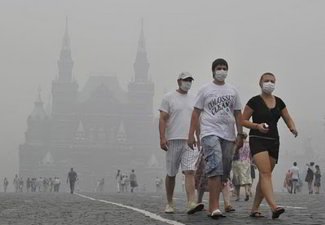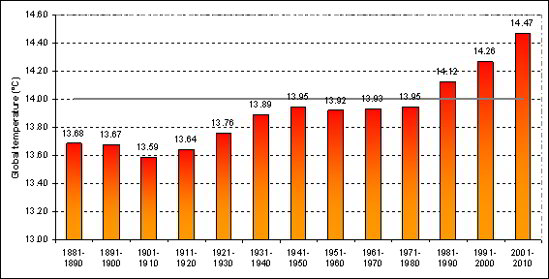 Geneva – The world experienced unprecedented high-impact climate extremes during the 2001-2010 decade, which was the warmest since the start of modern measurements in 1850 and continued an extended period of pronounced global warming. More national temperature records were reported broken than in any previous decade, according to a new report by the World Meteorological Organization (WMO).
Geneva – The world experienced unprecedented high-impact climate extremes during the 2001-2010 decade, which was the warmest since the start of modern measurements in 1850 and continued an extended period of pronounced global warming. More national temperature records were reported broken than in any previous decade, according to a new report by the World Meteorological Organization (WMO).
The report, “The Global Climate 2001-2010, A Decade of Climate Extremes”, analysed global and regional temperatures and precipitation, as well as extreme weather events such as the heat waves in Europe and Russia, Hurricane Katrina in the United States of America, Tropical Cyclone Nargis in Myanmar, droughts in the Amazon Basin, Australia and East Africa and floods in Pakistan.
The decade was the warmest for both hemispheres and for both land and ocean surface temperatures. The record warmth was accompanied by a rapid decline in Arctic sea ice, and accelerating loss of net mass from the Greenland and Antarctic ice sheets and from the world’s glaciers. As a result of this wide-spread melting and the thermal expansion of sea water, global mean sea levels rose about 3 millimetres (mm) per year, about double the observed 20th century trend of 1.6 mm per year. Global sea level averaged over the decade was about 20 cm higher than that of 1880, according to the report.
The WMO report charted rising atmospheric concentrations of greenhouse gases. Global-average concentrations of carbon dioxide in the atmosphere rose to 389 parts per million in 2010 (an increase of 39% since the start of the industrial era in 1750), methane to 1808.0 parts per billion (158%) and nitrous oxide to 323.2 parts per billion (20%).
“A decade is the minimum possible time-frame for meaningful assessments of climate change,” said WMO Secretary-General Michel Jarraud. “WMO’s report shows that global warming was significant from 1971 to 2010 and that the decadal rate of increase between 1991-2000 and 2001-2010 was unprecedented. Rising concentrations of heat-trapping greenhouse gases are changing our climate, with far reaching implications for our environment and our oceans, which are absorbing both carbon dioxide and heat.”
 “Natural climate variability, caused in part by interactions between our atmosphere and oceans – as evidenced by El Niño and La Niña events – means that some years are cooler than others. On an annual basis, the global temperature curve is not a smooth one. On a long-term basis, the underlying trend is clearly in an upward direction, more so in recent times,” said Mr. Jarraud.
“Natural climate variability, caused in part by interactions between our atmosphere and oceans – as evidenced by El Niño and La Niña events – means that some years are cooler than others. On an annual basis, the global temperature curve is not a smooth one. On a long-term basis, the underlying trend is clearly in an upward direction, more so in recent times,” said Mr. Jarraud.
Between 2001 and 2010, there was no major El Niño event, which normally leads to higher temperatures (as occurred in the then-record warm year of 1998). Much of the decade experienced either cooling La Niña or neutral conditions, except for the 2009/2010 moderate to strong El Niño.
The 100-page report and an executive summary, incorporating findings from a unique survey of 139 National Meteorological and Hydrological Services and socio-economic data and analysis from several UN agencies and partners, were released to coincide with the first session of the Intergovernmental Board on Climate Services. This Board is overseeing the implementation of the Global Framework for Climate Services – an international initiative to improve and expand scientifically-based climate information to help society cope with the natural variability of our climate and human-induced climate change.
“A decadal perspective makes it possible to assess trends in the climate system and anticipate the future. It can also inform efforts to develop operational climate services that provide information and forecasts for decision-making in agriculture, health, disaster risk, water resources and other sectors. These efforts are being coordinated through the WMO-led Global Framework for Climate Services,” said Mr. Jarraud.
“Climate services are more necessary than ever to help us cope with global changes in our climate, which are accentuated at regional and national scales. Despite the significant decrease in casualties due to severe storms and flooding, the WMO report highlighted an alarming impact on health and mortality rates caused by the European and Russian heat waves. Given that climate change is expected to lead to more frequent and intense heat waves, we need to be prepared,” said Mr. Jarraud.
Temperatures:
The average land and ocean-surface temperature for the decade 2001-2010 was estimated to be 14.47°C, or 0.47°C above the 1961–1990 global average and +0.21°C above the 1991–2000 global average (with a factor of uncertainty of ± 0.1°C).
The decadal rate of increase in the global temperature accelerated between 1971 and 2010. The global temperature increased at an average estimated rate of 0.17°C per decade during that period, compared with 0.062°C per decade for the entire 1880-2010 period. The average 2001-2010 decadal temperature was 0.21°C warmer than 1991–2000, which in turn was +0.14°C warmer than 1981-1990.
Every year of the decade except 2008 was among the 10 warmest years on record. The warmest year ever recorded was 2010, with a temperature estimated at 0.54°C above the 14.0°C long term average of 1961-1990 base period, followed closely by 2005.
Above-average temperatures were observed over most parts of the globe in 2001-2010. This was particularly marked in the higher latitudes of the northern hemisphere. Greenland recorded the largest decadal temperature anomaly, at +1.71°C above the long-term average and with a temperature in 2010 of +3.2°C above average. Africa experienced warmer than normal conditions in every year of the decade.


















